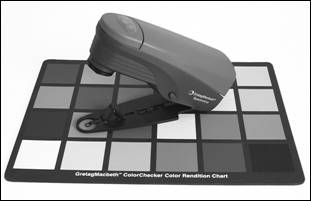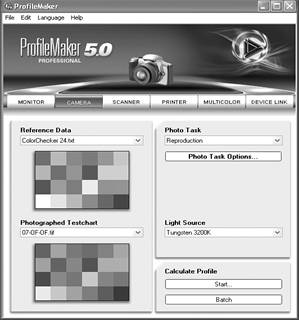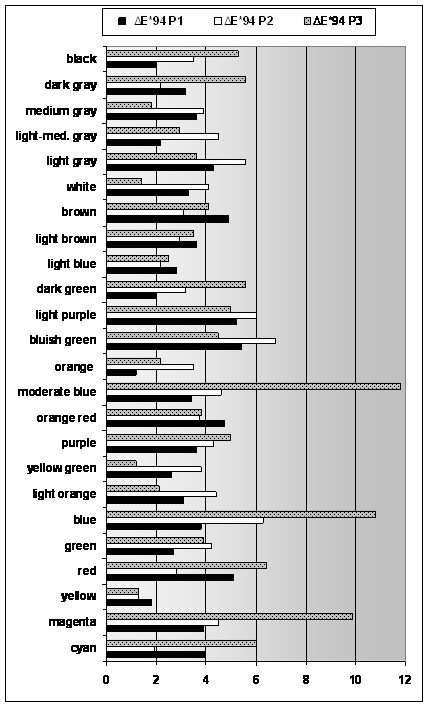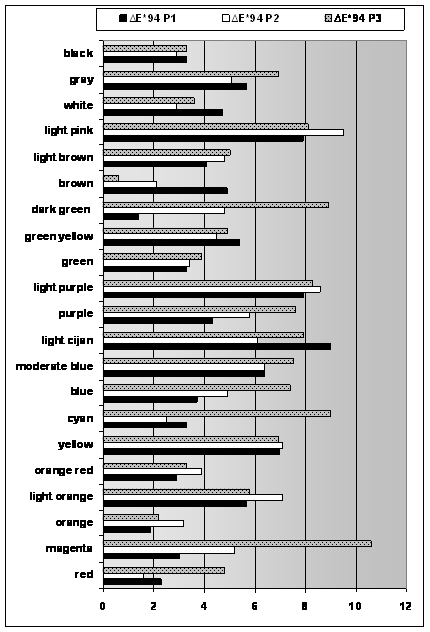International conference on Computer Aided Design and Manufacturing
CADAM'05.
DIGITAL CAMERA CHARACTERIZATION USING SPECIAL COLOR REFERENCE TARGET
Strgar Kurečić, M.; Agić, D. & Mandić, L.
Abstract:
Digital cameras on the market today, have a great potential to become the powerful tool for capturing images for use in all demanding fields, such as reproduction photography of artworks. In this research the ability of digital camera to accurately record the colors of art paintings was explored. The special color reference target for digital camera characterization was developed, applied and tested. The results show that using proposed methodology, the workflow efficiency and color accuracy can be improved.
Keywords:
color accurate reproduction, digital camera characterization, color management, color reference target, device profile
1. INTRODUCTION
With the rapid development of digital camera systems and image processing techniques, digital photography become well established and comparable to analog photography, both in price and image quality. Besides, digital imaging offers many advantages, such as processing flexibility, ease of storage, retrieval and distribution, as well as ease of reproduction. Many cultural-heritage institutions and museums, which are using photography as a means for documenting their collections and producing reproductions of their artifacts, recognized these advantages and started imaging using digital technology. Although, procedures for testing the quality of digital cameras have been established in the recent past, they have not been developed specifically for the direct digital capture of artwork [1].
When photographing subjects such as a painting or other original artwork, it is essential to reproduce colors as accurately as possible. For color accuracy, the most important characteristic of the digital camera are its spectral sensitivities. Ideally, they should closely resemble the human visual system's spectral sensitivities. But, because the colorants which can be used for color filters in digital cameras are very limited, it is not possible to produce the same spectral sensitivities as those of the average human observer. This is the underlying reason why color inaccuracies exist in digital images. The purpose of this research is to propose a methodology for digital image capture that minimizes the inherent limitations of many digital systems that are in use today.
2. PROBLEM FORMULATION
Besides on spectral sensitivities of digital camera system, the amount of color reproduction inaccuracy depends on accuracy of digital camera characterization. Since the spectral sensitivities of the camera cannot be changed, the camera characterization process plays the main role in accurate color reproduction. The digital camera characterization is a transform derivation process that defines a mapping between camera RGB signals (that are device-dependent values) and a device-independent color space, such as XYZ or CIELAB [2].
The color characterization method which is often used is method based on color reference target. The basic idea of color target-based characterization is to use a reference target that contains a certain number of color samples of known values. These color samples are then imaged by a digital camera and the resulting output is objectively compared to the original target, by measuring with spectrophotometer to obtain the RGB values and their corresponding CIE color space values. In this way, the accuracy of the imaging device can be determined and the device profile could be created for use within an ICC Color Management System. A profile for the device is created by way of a CLUT (color look-up-table) which adjusts the device's color values in order to produce an accurate reproduction of the captured image.
Ideally, color targets should span the color range of imaged objects and have similar spectral properties (made using similar colorants). For photographic and printed materials, standard targets are available. The problem is that for art objects (such as paintings), such targets are largely nonexistent [3]. When characterizing digital camera for capturing art paintings, the standard targets are used, resulting in unacceptable differences in reproducing some special colors, so lots of time must be spent in visual editing and color adjusting in various software applications (such as Adobe Photoshop). To avoid the need for excessive color editing, and to improve workflow efficiency and color accuracy, the special color reference target for digital camera characterization is developed, applied and tested in these research.
3. CALIBRATION VS. CHARACTERIZATION
One of the most important steps in any digitisation process is ensuring the hardware used for image capture is performing to an established standard. This involve first calibrating equipment and then employing Color Management software to characterize the device, creating an ICC (International Color Consortium) color profile that should provide consistent and predictable results from various devices in an imaging workflow.
In order to understand correctly the difference between calibration and characteri- zation, the explanation follows. The calibration is the establishment of the imaging device to a known state. This ensures that the device is providing consistent results between two times or two machines. Calibration is always the first task in any color management system.
The characterization is the establishment of the difference of any color between what is created (captured by imaging device) and what should have been made (captured). These differences are taken for a large range of colors and can provide a large color look-up-table, which provides the central information that makes up an ICC color profile.
4. BUILDING AND EVALUATING A CAMERA PROFILE
Creation of a camera profile starts with choosing a color reference target (characteri- zation target). Color samples from target are then measured with spectrophotometer, or previously measured data, target description file (TDF) accompanying the standard target can be used. The target is then photographed by the camera, delivering RGB values to the profile-building stage. The relationship between RGB and XYZ is derived and a device profile is created.
The accuracy of the profile is evaluated in two different ways:
Test A. Test of profile accuracy in predicting the characterization target used to build profile.
Test B. Test of profile accuracy in predicting the colors from original painting (evaluation target).
The purpose of Test A. was to ascertain that the prediction errors for the characterization dataset are low. Results from all three profiles will be compared. The prediction errors for Test B. can be expected to be higher than that of Test A. The flowchart in Figure 1. outlines the methodology for building and evaluating a camera profile.
Figure 1. Workflow for building and evaluating a camera profile
5. EXPERIMENTAL
The objects of digitalization process were paintings made in tempera. For this purpose, the special color reference target was made using the same pigments and same paper as those on paintings being photographed. The choice of color samples on the target was made on the model of often used target GretagMacbeth ColorChecker chart. Also, the same number of color samples (24) was used. After creation, the samples on target were measured using Spectrolino spectrophotometer (Figure 2). Measured values were saved in target description file in ProfileMaker application.

Figure 2. Spectrolino spectrophotometer on ColorChecker target
The target was photographed in controlled studio conditions. Illumination used was tungsten with correlated color temperature of 3200K. Image captures were performed with Nikon D70 digital camera and AF Nikkor zoom lens 35-70mm f /2.8. Exposure mode was manual. Sensitivity of the system was set to ISO 200. There was not any signal processing such as gamma correction, hue adjustment, sharpening or noise reduction during imaging. Captured image of target (TIFF format) was then supplied to the ProfileMaker software, witch relates camera RGB signals to measured CIEXYZ or CIELAB values from target to build a CLUT based transformation structure.

Figure 3. Screenshot of the ProfileMaker camera section
To be able to objectively compare the results of characterization done with developed target, the two standard color targets were also used for characterization; GretagMacbeth ColorChecker (with 24 color samples) and ColorChecker DC (with 237 color samples). The evaluation of profiles made from those targets was conducted using calibrated CRT monitor as a soft proofing device. Table 1. lists the equipment and experimental parameters used
Digital camera |
Nikon D70 |
Light source |
Osram Nitrafot B, 500W, Tungsten 3200K |
Color reference target (characterization target) |
• ; Special (24 color samples) |
Evaluation target |
21 color samples derived from original painting |
Measuring instrument |
GretagMacbeth Spectrolino spectrophotometer |
Profiling software |
GretagMacbeth Profilemaker PRO 5.02 |
Soft-proof device |
Mitsubishi Diamond PRO 2070 SB CRT monitor |
Table 1. Experimental equipment and parameters for testing accuracy of the digital camera ICC profile
6. RESULTS AND DISCUSION
By using three different color reference targets: our special target, and two standard targets, three profiles were made, named:
• P1 - profile made using our special target (made with same materials as paintings)
• P2 - profile made using ColorChecker (with 24 color samples)
• P3 - profile made using ColorChecker DC (with 237 color samples).
The accuracy of the profiles was evaluated in two different ways, previously described. First test ( Test A ) for evaluating the accuracy of the profiles was conducted by assigning the profiles to digital image of our special target in Photoshop. Using the monitor as a soft proofing device, color samples on images with assigned profiles was measured with Spectrolino (direct on monitor) and compared to original target values. The profiling evaluation results are shown in Figure 4.
Second test ( Test B ) was conducted to evaluate the profiles accuracy in predicting the colors from original painting. For that purpose, the three profiles were assigned to digital image of original painting and compared to values measured with Spectrolino directly from the original painting. Those results are shown in Figure 5.
|
|
Test A |
|
|
Test B |
|
profile |
∆E*94 |
special target |
∆E*94 |
original painting |
||
|
average |
max. |
min. |
average |
max. |
min. |
P1 |
3,4 |
5,4 |
1,2 |
4,6 |
9,0 |
1,4 |
P2 |
3,9 |
6,8 |
1,3 |
4,9 |
9,5 |
1,6 |
P3 |
4,6 |
11,8 |
1,2 |
6,0 |
11,5 |
0,6 |
Table 2. Profiling evaluation results
From the obtained results, it can be noticed that the average color errors are smallest on digital image with profile P1 assigned (Figure 4. and Figure 5.).

Figure 4. Profiling evaluation results - Test A

Figure 5. Profiling evaluation results - Test B
7. CONCLUSIONS
The results show that the differences in the colorants (pigments) used and different surface characteristics of the color reference target used for camera characterization may contribute to the color difference. The results also showed that having a color reference target containing more samples does not guarantee better performance. The number of samples in color reference target is less important then the spectral properties of the colorants used to create target.
In order to improve the accuracy of digital camera color reproduction the color reference target, used in the characterization process, should ideally be made from same materials (colorants and surface) as those used on objects being photographed. Some degree of accuracy can be maintained if the materials and surface textures have some similarities. Otherwise, the conversation from device dependent signals to device independent attributes will not be accurate.
Also, it is expected that the performance of digital image capture can improve using different lighting and more complex color processing, witch will be the subject of our future research.
References:
[1] Smoyer E.M.; Taplin L.A. and Berns R.S., (2005). Experimental Evaluation of Museum Case Study Digital Camera Systems , in Proc. IS&T Archiving Conference , IS&T, Springfield .
[2] Hong G.; Luo R.M.; Rhodes P., (2001). A Study of Digital Camera Colorimetric Characte- rization Based on Polynomial Modeling, Color Research and Application, pp.76-84, vol.26, number 1, February 2001, Willey , UK
[3] Berns R.S., (2000). The Science of Digitizing Two-Dimensional Works of Art for Color-Accurate Image Archives , Munsell Color Science Laboratory Technical Report, May 2000.
[4] Hunt G., Measuring Colour - 2 nd ed ., Ellis Horwood Limited, West Sussex , England , 1991.
[5] Mohammadi M., Nezamabadi M., Berns R.S., Taplin L.A., Spectral Imaging Target Development Based on Hierarchical Cluster Analysis , in Proc. of Twelfth Color Imaging Conference: Color Science and Engineering, Systems, Technologies and Applications , IS&T, Springfield, 2004, pp. 59-64.
[6] McDowell D.Q., Viewing Conditions, Colorimetric Measurements and Profile Making , IPA Bulletin, nov/dec., 2004.
Authors: M.Sc. Strgar Kurečić Maja, Ph.D. Darko Agić, M.Sc. Mandić Lidija, Faculty of Graphic Arts, Department for reproduction photography, Getaldićeva 2, Zagreb, Croatia, phone: +385 1 237 1080, fax: +385 1 2371 077, e-mail: mstrgar@grf.hr